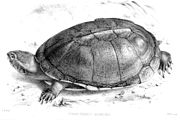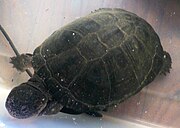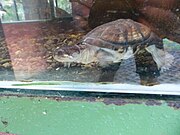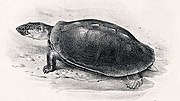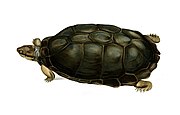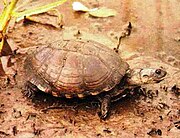Pelusios
| Pelusios | |
|---|---|

| |
| Pelusios castaneus | |
| Scientific classification | |
| Domain: | Eukaryota |
| Kingdom: | Animalia |
| Phylum: | Chordata |
| Class: | Reptilia |
| Order: | Testudines |
| Suborder: | Pleurodira |
| Family: | Pelomedusidae |
| Genus: | Pelusios Wagler,1830[1][2] |
| Species | |
|
See text | |
| Synonyms[1][2] | |
|
SternothaerusBell,1825 | |
Pelusiosis agenusof Africanside-necked turtles.With 17 describedspecies,it is one of the most diverse genera of theturtleorder (Testudines).
Etymology[edit]
The scientific namePelusiosis derived from theGreekword pēlos, which means "mud" or "clay",[3]and this is reflected by the turtles living in streams and rivers with a muddy bottom.
Common names[edit]
Common names for the genusPelusiosincludehinged terrapins,[4]African mud turtles,andmud terrapins.
Taxonomy[edit]
Several species have been described, with probably numerous undescribed species. Thetaxonomyof the genus is very confused, as these species show many local variations. Certain species, in isolated areas or with reduced populations, need to be observed as they face a distinct extinction possibility given the significant number collected by native people.
Geographic range[edit]
They are found throughoutSub-Saharan Africa,Madagascar,São Tomé,and theSeychellesislands. They have also been introduced on the islands of theLesser Antilles.
Description[edit]
The African mud turtles range from being small in size, only 12 cm (4.7 in) carapace length for adultPelusios nanus,to moderately large, 46 cm (18 in) for adultPelusios sinuatus,while the large majority of species fall between 20 and 30 cm (7.9 and 11.8 in) carapace length.[5]Thecarapacesare oblong, moderately high-domed, and theplastronsare large and hinged which is what distinguishes them from thePelomedusa.[5][6]The plastron contains a mesoplastron and also well-developed plastral buttresses that articulate with thecostalson each side of the carapace.[5]The carapace has 11 pairs of sutured peripherals around its margin and a neck withoutcostiform processes.[5]The jaw closure articulates on apterygoidtrochlear surfacewhich lacks a synovial capsule but instead contains a saclike duct full of fluid from the mouth cavity.[5]The head shape is wide and flat, with a seemingly "smiling" face created by the jaw closure.[6]The skull lacks the epipterygoid bone (bone above the pterygoid extending toparietal bone) and parietal-squamosalcontact but possesses an internalcarotid canaland strongpostorbital-squamosalcontact.[5]
Biology[edit]
The mud terrapins are eithersemiaquaticor fullyaquaticand typically walk on the floor of slow-moving waters. They are most often observed in lakes, swamps or marshes but occasionally witnessed inephemeralwaterways.[5]They are predominantlycarnivorous,eating a variety ofarthropods,worms, or other small animals found by way offoragingthe bottom of their aquatic habitats.[5]They do not undergo prolongedestivationorhibernationin the dried mud during dry season; instead, they need to find a wet or humid place to survive.[6]Pelusiosgenerally produce small to modestclutchesof 6 to 18eggs,depending upon female size.[5][7]Egg deposition occurs in the more equitable season of the year, with known incubation periods ranging from 8–10 weeks.[5]The reportedkaryotypeis 2N = 34 with 22 macrochromosomes and 12microchromosomes.[8] The southern group of the genusPelomedusais shown to beparaphyleticallysimilar toPelusiosthroughmitochondrial DNAanalyses.[2][9]From fossil evidence, it is suggested that thegeneradiverged in, or before the lowerMiocene era.[9]
List of species[edit]
The species in the genusPelusioscan be divided into two groups based on shell morphology. The "adansonii group" (also known as the "gabonensis group" or the "adansonii-gabonensis group" ) includesP. adansonii,P. broadleyi,P. gabonensis,P. marani,andP. nanus.Species in the "adansonii group" are characterized by short abdominalscutesrelative to the elongate anterior plastral lobe, as well as a short bridge between the carapace and the plastron.[2]All of the remaining species are characterized by relatively longer abdominal scutes and a longer bridge between the carapace and plastron and are referred to as the "subniger group".[2][8]Species in the "subniger group" exhibit greater mobility of the plastral front lobe than those belonging to the "adansonii group".
Status[edit]
Based on field surveys, a 50% decrease has been observed in the Seychelles terrapins, which include variousPelusiosspecies.[13]Seychelles is considered a hotspot forbiodiversity,as it is one of the most threatened reservoirs of plant life and animal life, as well as one of the richest environments.[14]The species are endangered due to threat ofdrainage,predation,andinvasionby alien flora, combined with a shrunken living area.[13][14]Mosthabitat destructionis from human population expansion, specifically in thegranitic islandsdue to increased development pressures.[14]Hope for reversal of this trend is evidenced by the rapid population recovery ofPelusios subniger parietalisonFrégate Islandafter habitat improvement.[13] Globalclimate changehas recently been recognized as one of the largest threats to biodiversity.[15]This climate change has the ability to change species survival by causing changes in ecosystem structures,[14]yet the effect is heightened inendemicspecies.[15]Several reviews undertaken for the study of potentialeffects of global warmingon biodiversity have provided evidence for Africa being the most vulnerable of all continents.[16]Climate change is likely to be devastating for many species confined to small islands such as Seychelles.[14]Endemic species such asPelusioscould suffer the worst impact of climate change because of their restricted range and narrow ecological requirements.
Notes[edit]
- ^Abinomial authorityin parentheses indicates the species was originally described in a genus other thanPelusios.
References[edit]
- ^abcRhodin et al. 2011,p. 000.215
- ^abcdeFritz & Havaš 2007,pp. 345–346
- ^Merriam Webster - Pelusios -Website
- ^Branch, Bill.2004.Field Guide to Snakes and Other Reptiles of Southern Africa.Sanibel Island, Florida: Ralph Curtis Books. 399 pp.ISBN0-88359-042-5.(GenusPelusios,p. 46).
- ^abcdefghijVitt, Laurie; Calwell, Janalee (2008).Herpetology.Wiltham, Massachusetts: Academic.ISBN978-0-12-374346-6.
- ^abcBonin, Franck; Devaux, Bernard; Dupre, Alain (2006).Turtles of the World(Third ed.). Baltimore, Maryland: Johns Hopkins University Press.ISBN0-8018-8496-9.
- ^Franklin, C (2007).Turtles: An extraordinary natural history 245 million years in the making.St. Paul, Minnesota: Voyageur Press.ISBN978-0-7603-2981-8.
- ^abErnst, C; Barbour, R. (1989).Turtles of the World.Washington D.C.: Smithsonian Press.ISBN0-87474-414-8.
- ^abVargas-Ramirez M, Vences M,Branch WR[in French],Daniels SR,Glaw F,Hofmeyr MD, Kuchling G, Maran J, Papenfuss TJ, Siroký P, Vieites DR, Fritz U (July 2010). "Deep genealogical lineages in the widely distributed African helmeted terrapin: Evidence from mitochondrial and nuclear DNA".Molecular Phylogenetics and Evolution.56(1): 428–440.doi:10.1016/j.ympev.2010.03.019.PMID20332032.
- ^The Reptile Database. reptile-database.org.
- ^Turtle Taxonomy Working Group[van Dijk, P.P., Iverson, J.B., Rhodin, A.G.J., Shaffer, H.B., and Bour, R.]. 2014. "Turtles of the World, 7th edition: annotated checklist of taxonomy, synonymy, distribution with maps, and conservation status". In: Rhodin, A.G.J., Pritchard, P.C.H., van Dijk, P.P., Saumure, R.A., Buhlmann, K.A., Iverson, J.B., and Mittermeier, R.A. (Eds.).Conservation Biology of Freshwater Turtles and Tortoises: A Compilation Project of the IUCN/SSC Tortoise and Freshwater Turtle Specialist Group.Chelonian Research Monographs 5(7):000.329–479doi:10.3854/crm.5.000.checklist.v7.2014
- ^Bruce G. Marcot, "Two Turtles from Western Democratic Republic of the Congo:Pelusios chapiniandKinixys erosa."Includes photos.
- ^abcGerlach, J (August 2008). "Fragmentation and demography as causes of population decline in Seychelles freshwater turtles (genusPelusios) ".Chelonian Conservation and Biology.7:78–87.doi:10.2744/ccb-0635.1.S2CID85364146.
- ^abcdeBombi, Pierluigi; D'Amen, Manuela; Gerlach, Justin; Luiselli, Luca (2009). "Will climate change affect terrapin conservation in Seychelles".Phelsuma(17A): 1–12.
- ^abThomas CD, Cameron A, Green RE, Bakkenes M, Beaumont LJ, Collingham YC, Erasmus BFN, de Siqueira MF, Grainger A, Hannah L, Hughes L, Huntley B, van Jaarsveld AS, Midgley GF, Miles L, Ortega-Huerta MA, Peterson AT, Phillips OL, Williams SE. 2004. "Extinction risk from climate change".Nature427:145–148.
- ^Hulme M. 1996.Climate Change and Southern Africa: an Exploration of Some Potential Impacts and implications in the SADC.Norwich: United Kingdom: WWF International and Climate Research Unit, UEA. 104 pp.
Bibliography[edit]
- Rhodin, Anders G.J.; van Dijk, Peter Paul; Iverson, John B.; Shaffer, H. Bradley; Roger, Bour (2011-12-31)."Turtles of the World, 2011 update: Annotated checklist of taxonomy, synonymy, distribution and conservation status"(PDF).Chelonian Research Monographs.6.Archived(PDF)from the original on 2012-01-31.
- Fritz, Uwe; Havaš, Peter (2007-10-31)."Checklist of Chelonians of the World"(PDF).Archived(PDF)from the original on 2011-05-01.Retrieved2010-12-29.
- Caldwell, Analee; Vitt, Laurie. (2008).Herpetology.Waltham, Massachusetts: Academic Press. Print.
- Wagler, J.1830.Natürliches System der AMPHIBIEN, mit vorangehender Classification der SÄUGTHIERE und VÖGEL. Ein Beitrag zur vergleichenden Zoologie.Munich, Stuttgart and Tübingen: J.G. Cotta. vi + 354 pp. + one plate. (Pelusios,new genus, p. 137). (inGermanandLatin).

